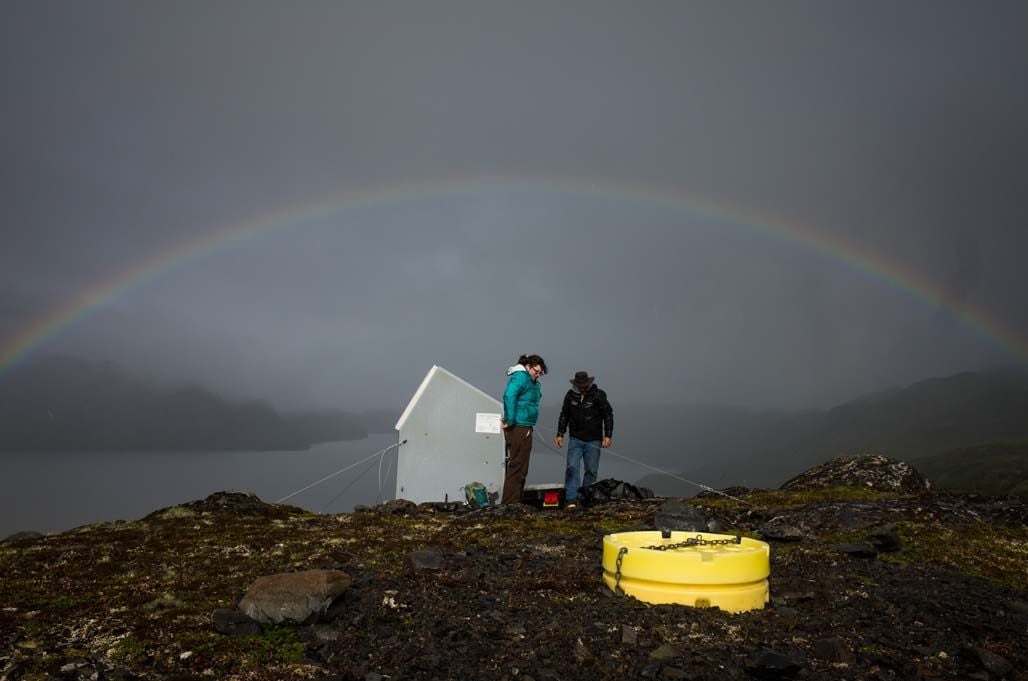FAIRBANKS — The North Korea nuclear test on Tuesday shook the world, raising concerns about national security and international relations, but it also quite literally shook the seismic sensors on Murphy Dome.
In fact, it registered on seismometers throughout the University of Alaska earthquake center’s statewide network, producing readings that state seismologist Michael West called “fascinating” in a blog post after the news broke.
The Alaska Earthquake Information Center’s mission is to monitor earthquakes, West said in an interview Thursday, but nuclear explosions — even ones more than 3,000 miles away — create similar readings.
“We record when the ground shakes. It doesn’t matter if it’s an earthquake, a landslide, a volcanic eruption, an explosion, buildings falling down, avalanches. If it shakes the ground, we end up recording it,” he said. “We detect an earthquake in Alaska about every 15 minutes. That process is set up and tuned to look for certain signals and it saw a nice clear signal the other day, and it said, ‘Yep, I got that one. It looks like it’s in North Korea.’”
North Korea claimed it successfully set off a hydrogen bomb, which are orders of magnitude more powerful than the traditional fission bombs, but those claims faced almost immediate skepticism from nuclear experts.
White House Press Secretary Josh Earnest said the initial analysis of the event was “not consistent with North Korean claims of a successful hydrogen bomb test.”
West is by no means an expert or authority on nuclear explosions, but he said one of the indicators scientists will use to determine just what North Korea detonated are the seismic readings. In short, West said, those shakes just weren’t big enough.
“When you hear the White House say the data is inconsistent with a hydrogen bomb explosion, what they’re really saying is, ‘Hmm, this data looks exactly identical to the last time and last time was not a hydrogen bomb, so what gives?’” he said.
The last time North Korea conducted a nuclear test was in 2013, when it detonated a traditional fission bomb. West put together an overlay with the readings from that explosion and the readings from Tuesday’s explosion.
“It doesn’t take that much to look at it and say, ‘Huh, it looks exactly the same as last time,’” he said.
The overlay was posted alongside his blog post and shows uncannily similar spikes and valleys of the two explosions, with Murphy Dome registering about eight seconds before Porcupine Dome in both cases.
West said he and many scientists often wrestle with balancing the terrible costs to human life of a disaster with the scientific interest of such events. Earthquakes in India and Nepal will kill thousands, but often there is something new and different to learn from the events, he said.
It also often strikes closer to home.
West said he’ll never forget being in New York City on Sept. 11, 2001.
“I spent the day looking at the seismic data of the collapse of the towers,” he said. “I felt guilty about it. I felt like I was doing something wrong, and yet we actually learned really insightful things from it.”
His own field is where it is today in large part because seismic readings were an effective way to monitor for nuclear explosions during the Cold War. He added that one of the sensors in the first global seismic network was located on the University of Alaska Fairbanks campus.
“The field of seismology took a quantum leap during the Cold War, specifically because of the interest in nuclear explosion detection,” he said.
The Geophysical Institute at UAF is home to the Wilson Alaska Technical Center, which helps operate specialized audio listening devices and seismic readings to help monitor nuclear events and provide valuable information as part of the Comprehensive Nuclear-Test-Ban Treaty.
Curt Szuberla, the director of the center, said in an email the North Korea tests aren’t likely to show up on the agency’s audio listening devices because of the nature of the explosion and the distance, but he said that seismic and, later, gas and air particulate data will be critical in understanding the recent explosion better.
Interest in Tuesday’s detonation has been high among seismologists and many like West are poring over the readings and discussing their observations, all hoping to understand the event better.
“There’s a good reason for investing time and energy into investigating signals like this,” West said. “If they really do a detonation at some point that’s 10 times larger, we’re going to know.”
West’s post can be found online at http://earthquake.alaska.edu/thoughts-north-korea-nuclear-test.
Contact staff writer Matt Buxton at 459-7544. Follow him on Twitter attwitter.com/FDNMpolitics.








No comments :
Post a Comment